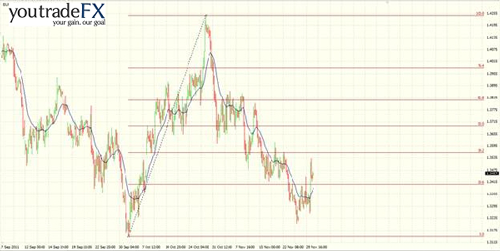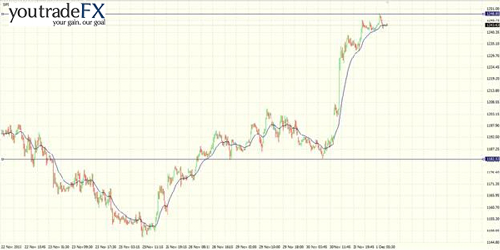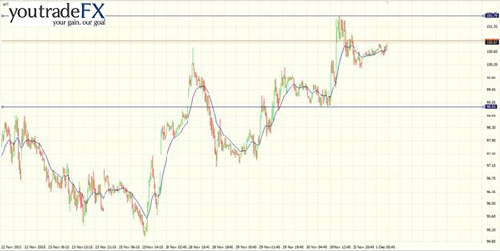Six of the world's largest central banks - Fed, ECB, SNB, BoE, BoC, and BoJ, agreed to lower USD swap rates by 50bps and extended the swap lines until Feb. 2013.This action was aimed at boosting Dollar liquidity and is regarded as a backup plan in the event of a worsening in global financial conditions, according to Michael Feroli, chief U.S. economist at JPMorgan Chase & Co.
The National Association of Realtors released a report on Wednesday showing a much bigger than expected increase in pending home sales in October. U.S Pending home sales index jumped 10.4 percent to 93.3 in October after falling 4.6 percent to 84.5 in September.
China’s stocks Increased the most in 18 months, after the Chinese government cut the reserve-ratio requirement by half a percentage point for lenders for the first time since 2008 and according to UBS AG this move may add 350 billion yuan ($55 billion) to the financial system. On the other hand, the China Federation of Logistics and Purchasing said The Purchasing Managers’ Index fell to 49.0 in November from 50.4 in October for the first time since February 2009.
An official data showed Wednesday, that Eurozone inflation held steady at a three year high in November despite an economic slowdown. While the jobless rate rose to a more than 13-year high. Spain and France are going auction 8.25 billion euros ($11 billion) of bonds today. Spain will sell 3.75 billion euros of notes as the extra yield on its 10-year bonds and France will auction 4.5 billion euros of its 10- year bonds. The auctions will test investor confidence in the Euro-Zone.
The Euro rallied from lows in the region of 1.3255 -1.3260 to a session high of 1.3535 yesterday after China cut its bank reserve ratio by 50 bps and then, 6 major central banks extend swap lines to ease European financial fears, by cutting dollar swaps by 50bp. The pair should be traded with vigilance until ECB meeting & EU summit next week. The pair is currently trading in the narrow range of 1.3420-1.3535, hovering around the 38.2% retracement level. The pair resistance level is at 1.3535 and the current support level is at 1.3413, Tuesday’s low level.
The U.S Dollar fell significantly by a little more than 80pips yesterday from a session high of 78.14 to a session low of 77.28 but then pick up later in the same session to trade above the 77.50 level in line with market reaction and flow on effect of a weaker dollar. Today, the pair was slightly up in Asia and is trading in the narrow range of 77.50-77.75. The pair seems to be on its way to the broke the 61.8% retracement and heading toward the 78.00 level. The pair has support at 77.28 and the resistance is at 77.28.
The pair gained the most during the European and US sessions yesterday as the news that the global reserves are coordinating to help aid liquidity to the European Banks has seen the risk sentiment increase greatly with the AUD rallying almost 400 points off the daily low. The pair is currently trading just above the 1.2000 level. The pair is likely to fell slightly today on the back of profit taking.
U.S. stocks advanced, after six central banks took action on Europe’s debt crisis by making it cheaper for lenders to borrow in dollars. The S&P 500 jumped to 1246.91 yesterday and today the index is trading in narrow range 1231.70-1248.80points. Investor should remain cautious on the index as reports on U.S. ISM Manufacturing & Prices Paid and the U.S Employment report will be published this week.
Oil rose for a fifth day after six central banks cut the cost of dollar funding to ease a European debt crisis that threatens economic growth. Crude for January delivery climbed as much as 45 cents, or 0.5 percent, to $100.81 a barrel in electronic trading on the New York Mercantile Exchange and was at $100.78. The commodity is currently trading slightly up at 100.87 a barrel and seems to have stabilized above 100.40 levels and it seems that there won’t be major fluctuations on the commodity.
- English (UK)
- English (India)
- English (Canada)
- English (Australia)
- English (South Africa)
- English (Philippines)
- English (Nigeria)
- Deutsch
- Español (España)
- Español (México)
- Français
- Italiano
- Nederlands
- Português (Portugal)
- Polski
- Português (Brasil)
- Русский
- Türkçe
- العربية
- Ελληνικά
- Svenska
- Suomi
- עברית
- 日本語
- 한국어
- 简体中文
- 繁體中文
- Bahasa Indonesia
- Bahasa Melayu
- ไทย
- Tiếng Việt
- हिंदी
Daily Market Analysis: Currency Report
Published 12/01/2011, 06:08 AM
Updated 03/09/2019, 08:30 AM
Daily Market Analysis: Currency Report
Latest comments
Loading next article…
Install Our App
Risk Disclosure: Trading in financial instruments and/or cryptocurrencies involves high risks including the risk of losing some, or all, of your investment amount, and may not be suitable for all investors. Prices of cryptocurrencies are extremely volatile and may be affected by external factors such as financial, regulatory or political events. Trading on margin increases the financial risks.
Before deciding to trade in financial instrument or cryptocurrencies you should be fully informed of the risks and costs associated with trading the financial markets, carefully consider your investment objectives, level of experience, and risk appetite, and seek professional advice where needed.
Fusion Media would like to remind you that the data contained in this website is not necessarily real-time nor accurate. The data and prices on the website are not necessarily provided by any market or exchange, but may be provided by market makers, and so prices may not be accurate and may differ from the actual price at any given market, meaning prices are indicative and not appropriate for trading purposes. Fusion Media and any provider of the data contained in this website will not accept liability for any loss or damage as a result of your trading, or your reliance on the information contained within this website.
It is prohibited to use, store, reproduce, display, modify, transmit or distribute the data contained in this website without the explicit prior written permission of Fusion Media and/or the data provider. All intellectual property rights are reserved by the providers and/or the exchange providing the data contained in this website.
Fusion Media may be compensated by the advertisers that appear on the website, based on your interaction with the advertisements or advertisers.
Before deciding to trade in financial instrument or cryptocurrencies you should be fully informed of the risks and costs associated with trading the financial markets, carefully consider your investment objectives, level of experience, and risk appetite, and seek professional advice where needed.
Fusion Media would like to remind you that the data contained in this website is not necessarily real-time nor accurate. The data and prices on the website are not necessarily provided by any market or exchange, but may be provided by market makers, and so prices may not be accurate and may differ from the actual price at any given market, meaning prices are indicative and not appropriate for trading purposes. Fusion Media and any provider of the data contained in this website will not accept liability for any loss or damage as a result of your trading, or your reliance on the information contained within this website.
It is prohibited to use, store, reproduce, display, modify, transmit or distribute the data contained in this website without the explicit prior written permission of Fusion Media and/or the data provider. All intellectual property rights are reserved by the providers and/or the exchange providing the data contained in this website.
Fusion Media may be compensated by the advertisers that appear on the website, based on your interaction with the advertisements or advertisers.
© 2007-2025 - Fusion Media Limited. All Rights Reserved.
